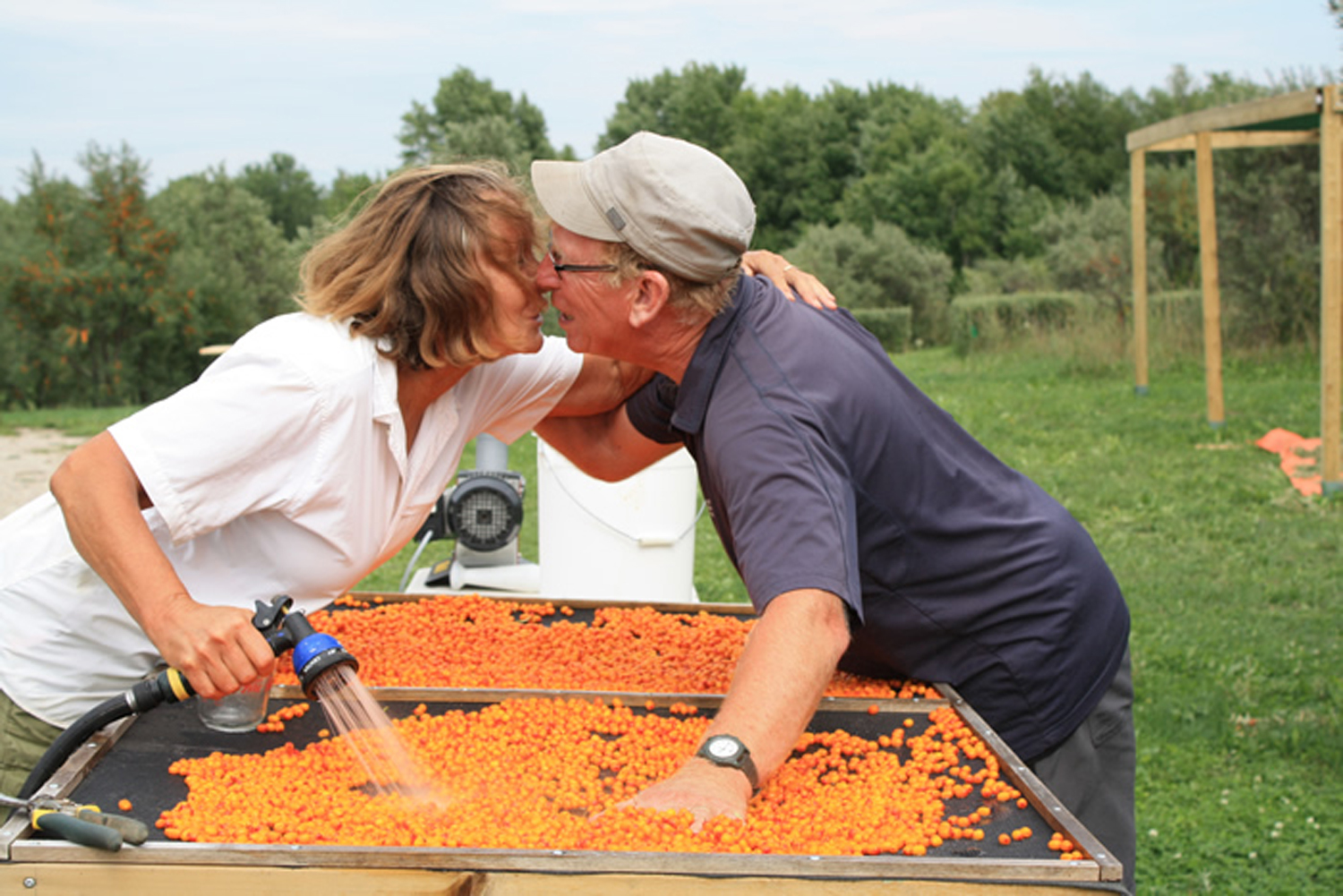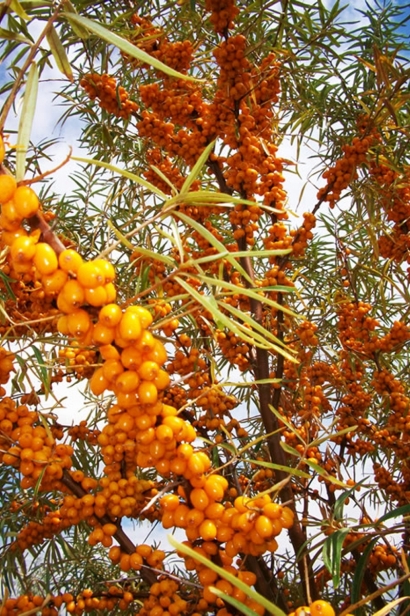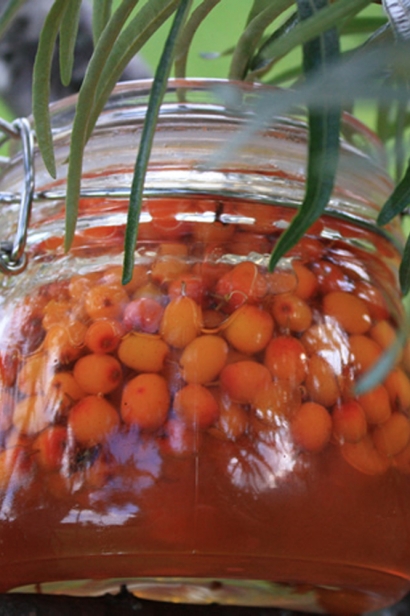Healing Arc Grows Nutritional Gold Sea Buckthorn
Our journey into the study of sea buckthorn as a value-chain crop began in 2001. We now refer to this experience as our Sea Buckthorn Odyssey. I am sure we could give Homer’s epic poem some competition with the challenges, experiences, travels, and people we have met along the way. Over the past fifteen years, awareness of this amazing plant has increased dramatically and our goal is to persist in promoting sea buckthorn until it becomes widely known as the Citrus of the North, our gift to future generations.
Sea buckthorn is a unique and diverse plant. It is not only a viable crop species but it can also be used as a soil stabilizer in land reclamation projects, a habitat for a diversity of song birds, and a fixer of nitrogen to improve soil quality. Sea buckthorn (Hippophae rhamnoides L) should not be confused with common buckthorn, sometimes known as European buckthorn (Rhamnus cathartica).
Sea buckthorn grows well on sand dunes by the sea (hence the name) and the erosion-control varieties can be seen along the shores in Great Britain. It will tolerate great amounts of moisture but not areas that are continually wet. It is also salt tolerant, which makes it wonderful as a hedge.
Our company, The Healing Arc Inc., was named for an African symbol that includes a rainbow, a rock, and a boat. The symbol represents hope. I refer to myself as the plant manager and my partner and co-owner, Rodger Hunter Shankland, as the branch manager. We are located on 80 acres of rolling marginal land in Bruce County. Approximately 13 acres of this land is dedicated to the growing and production of sea buckthorn, deciduous shrubs in the family Elaegnaceae.
The history of sea buckthorn as a crop dates back to ancient Greek times and is mentioned in the writings of ancient Greek scholars. According to legend, sea buckthorn was a key part of the diet of horses and this led to its generic Latin name Hippophae, which translates to “shiny horse.” Folklore also tells us that sea buckthorn leaves were the favoured food of the mythical flying horse Pegasus.
For centuries, European and Asian cultures haves recognized the medicinal properties of sea buckthorn (in the leaves, berries, and even the bark of the tree). Clinical investigations on medicinal uses of sea buckthorn were initiated in Russia during the 1950s and the oil from sea buckthorn berries and seeds is approved for clinical use in hospitals in Russia and China, where it was formally listed in the Pharmacopoeia in 1977.
The sea buckthorn plant, which sheds its leaves annually, can survive temperatures ranging from plus 40 to minus 40 degrees Celsius. It is dioecious, meaning that both a male and a female tree are required to produce fruit. In an orchard, one male can pollinate about five females, and only the female plant produces fruit. The plants are wind-pollinated, drought-resistant, and like the sun. Sea buckthorn plants do not tolerate wet soil and prefer alkaline to acidic soil. They are naturally nitrogen-fixing and resistant to pests.
This wonder plant provides excellent wildlife habitat and can be effectively used for land reclamation and to prevent or remedy soil erosion.
It is for these purposes that sea buckthorn was initially introduced in Canada’s Western provinces in the early 2000s. These wonderful uses have, however, led to some confusion when selecting sea buckthorn plants. I would not hazard to guess how many varieties actually exist. Like many deciduous trees there is diversity in the choice you make. Take a maple tree, for example. There are red maples, sugar maples, Japanese maples, and others too numerous to mention. This applies to sea buckthorn, as well.
When purchasing sea buckthorn plants, knowing your variety and your purpose in growing them are critical. Many of the plants sold in nurseries are the ornamental or erosion-control varieties and it takes approximately twenty of the tiny berries these varieties produce to equal the weight of one berry from the sea buckthorn trees grown at the Healing Arc. When purchasing sea buckthorn plants, remember that you need a male and a female and do not forget to ask the approximate weight or size of the berry.
Sea buckthorn is my passion and I could write on and on about the many uses of this plant and its nutritional properties. The berry is the most nutrient-dense of all berries available. It contains less than one percent sugar, making it an excellent source of Vitamin C. (Approximately eight berries supply the daily allotment.) It’s also high in vitamin A, retinol, beta carotene, and potassium, and 100 grams of sea buckthorn berries contain only 72 calories. What really sets sea buckthorn apart from other berries is that it contains essential fatty acids.
On our orchard, sea buckthorn is grown only for the berries, which are used for the fruit, juice, oil, and pulp. Mastering the propagation of our sea buckthorn plants from cuttings took nine years of trial and error to reach a 75 percent success rate. Harvesting from leaders has been the most effective method.
We imported our original sea buckthorn stock from Latvia, due to the fact that we wanted to ensure our stock came from a climate where conditions are similar to the climate we experience in South Bruce.
Upon their arrival, we fastidiously tagged our plants as male or female and carefully charted the planting of our initial orchard of six hundred Sea Buckthorn trees in late June. We waited…. In August of the following year, as I was carefully weeding my retirement investment, I was rewarded with the harvest of five sea buckthorn berries. I was thrilled; the shock was that they were from a supposedly male plant. Perhaps this does not seem like a major catastrophe, but during the previous year I had been supplying the University of Guelph with cuttings from these plants for growth trials. Needless to say, a year of research now had no validity.
The words from the song “Hope” by Shaggy became my mantra:
In this life you could lead if you only believe
And in order to achieve what you need
You can never give up.
Following this discovery, we needed to regroup and decide the best way to move forward. We knew we would have sea buckthorn berries within a few years but propagation of additional sea buckthorn plants was not an option until gender was clearly identified.
From our 600-plus sea buckthorn plants we now knew for certain that we had one female. Patience is certainly a virtue I have had a struggle with all my life; this, however, was testing it to the limit.
The following year we were amazed. Our trees had grown dramatically. In late June we discovered that many of our trees had a significant number of green berries on them, which we had not noticed earlier since we hadn’t known what to look for. To say we were pleased would be an understatement. We were delighted. But as the season progressed we discovered many variations in the sizes and colour of the berries. What we now knew was that our original stock was a selection of random sea buckthorn tree varieties and we would need to establish a system of identification.
Over the past ten years we have established just such a system. The three main female sea buckthorn plants we market are Citrus Gold, Huron Sunset, and Citrus Blaze. The male sea buckthorn plant that we market is called Lord. At least twenty-five small orchards in Ontario have been supplied with our sea buckthorn plant stock, as well as hundreds of individuals who have planted on a smaller scale for personal use, permaculture, or just for the sheer beauty of the plant.
When we sell a plant we inform the purchaser that with sea buckthorn, the first year it sleeps, the second year it creeps, and the third year it leaps. A sea buckthorn plant purchased from us in a one-gallon container will triple its size in one year. And a bonus for ease of growing: netting is not required to protect the crop from birds, since they prefer berries that are sweet.
Needless to say, when I first decided that I would grow sea buckthorn as a value-chain plant it was almost completely unknown in Canada. We attended many events and festivals. I have spoken at the International Herb Association Conference, numerous horticultural societies, and environmental events. There were days when I felt I could not say the words “sea buckthorn” one more time. Well, we now have a brochure!
I am still amazed when people ask what we grow and they say “sea buck WHAT?”
Nonetheless, when I break down what has been accomplished in the past fifteen years into bite-sized pieces I am amazed. We have progressed from having one acre of sea buckthorn trees of indeterminate variety and gender to five acres of carefully tended and clearly identified trees.
Our sea buckthorn berries and juice are used in many restaurants. (Hibiscus restaurant in Kensington Market uses our berries and juice, with which they even make fabulous ice cream!) Our creams and oil are carried by numerous health-care professionals. Above all, it is our individual clients who have supported us and shared by word of mouth the experience of the miracle orchard.
I equate the success of our Sea Buckthorn Odyssey with the power of seniors and the love of family and friends. I am humbled by the support I received when I needed shoring up. I am grateful for the friendships and physical help when I have been overwhelmed. My partner Rodger has remained steadfast and reliable throughout this journey and is the artist of the orchard.
The Healing Arc
Sideroad 25 South
Fire #166, Teeswater, Ontario
(519) 357-3383
Editor’s note: The Healing Arc’s 11th Annual Harvest Open House begins on August 16 and ends on September 5, daily from 9 to 5. More details are available on their website.






